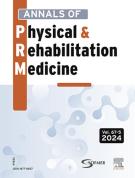Influence of adolescent idiopathic scoliosis on dynamical strategies in the sagittal plane - 26/09/17
Résumé |
Objective |
Adolescent idiopathic scoliosis (AIS) is a progressive growth disease that affects dynamic stability during upright stance, lateral step and gait, especially in frontal plane. The aim was to identify for AIS group and control group (CG) the dynamic strategies during 3 movements in sagittal plane: gait initiation, unstable sitting and positional trunk sense.
Material/patients and methods |
The first test included 10 AIS girls (Cobb>15°) and 15 healthy subjects (CG). The ground reaction forces (GRF) have been recorded during initiation gait. Force amplitudes, occurrences, impulses and asymmetry index (AI) have been computed. The second test included 12 AIS girls (Cobb>19°) and 15 healthy subjects. The GRF parameters (force amplitudes, number of oscillations and variability) were studied whilst the subjects maintained their balance in sitting position on a seesaw (anteroposterior destabilization, 10s). The third test included 13 AIS girls (Cobb>15°) and 16 healthy subjects. We recorded the positional sense for a target position of 30° of trunk flexion and 10° of extension. For each study, a threshold value of P<0.05 was adopted for ruling out the null hypothesis.
Results |
Whichever limb was used to initiate gait, the duration was significantly longer for AIS patients than CG (P<0.01). The impulses, occurrences and forces values were greater than CG (P<0.05), especially if the step initiation started with concavity limb. In sitting destabilization, the AIS was associated with an increase of GRF variability, occurrences, delta and the concavity side duration (P<0.03). In both target positions, the positional error increased for AIS group compared to CG (P<0.0008). The Cobb angle was only correlated with parameters for unstable sitting position (0.50≤r≤0.88) and with the positional error (0.16≤r≤0.82).
Discussion, conclusion |
The AIS is associated with specific dynamical strategies when the movement is in sagittal plane. In comparison with the frontal plane movement, this direction highlights the link between the severity of curvature and the perturbations.
Le texte complet de cet article est disponible en PDF.Keywords : AIS, Cobb angle, Sagittal plane, Dynamic strategies
Plan
Vol 60 - N° S
P. e79-e80 - septembre 2017 Retour au numéroBienvenue sur EM-consulte, la référence des professionnels de santé.


